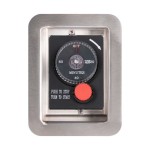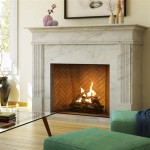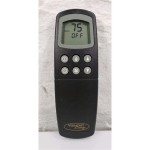Gas Fireplace Logs With Remote Control: Convenience and Comfort
Gas fireplace logs with remote control offer a convenient and aesthetically pleasing alternative to traditional wood-burning fireplaces. These systems provide the ambiance and warmth of a fire without the hassle of gathering, storing, and burning wood. The added benefit of remote control functionality significantly enhances user experience, allowing for effortless operation and temperature management. This article examines the features, benefits, installation considerations, and safety aspects of gas fireplace logs with remote control.
Gas fireplace logs are designed to mimic the appearance of natural wood, creating a realistic and visually appealing focal point within a living space. They are typically constructed from ceramic or refractory cement, materials that are heat-resistant and able to withstand high temperatures. These logs are arranged within the firebox of an existing fireplace or a purpose-built gas fireplace unit. A burner system located beneath the logs disperses natural gas or propane, which is then ignited to produce the flames. The remote control component adds a layer of automation, allowing users to adjust the flame height, temperature, and even set timers from a distance.
Key Features and Components
A gas fireplace log set with remote control comprises several key components working together to provide a reliable and user-friendly heating experience. Understanding these components is crucial for proper operation and maintenance.
Log Set: The log set itself consists of meticulously crafted artificial logs that closely resemble various types of wood, such as oak, birch, or pine. The quality of the log set significantly impacts the overall aesthetic appeal of the fireplace. High-end log sets often feature intricate details and realistic textures, enhancing the visual experience. The positioning of the logs is also important for optimal flame distribution and heat output. Manufacturers typically provide specific instructions on how to arrange the logs for best performance.
Burner Assembly: The burner assembly is the heart of the gas fireplace system. It consists of a burner tube or pan, which houses the gas jets that release fuel. The burner is typically constructed from stainless steel or cast iron for durability and resistance to corrosion. The design of the burner influences the flame pattern and overall heat output. Some burners are designed to create a more randomized and natural-looking flame, while others prioritize efficient heat distribution.
Gas Valve: The gas valve regulates the flow of gas to the burner. It is a critical safety component that controls the gas supply based on user input from the remote control or manual controls. The gas valve may be a simple on/off valve, or it may incorporate a modulating valve that allows for precise flame height adjustments. High-quality gas valves are designed to be reliable and leak-proof, ensuring safe operation over the long term.
Pilot Light Assembly: The pilot light is a small, continuous flame that ignites the main burner when the gas is turned on. The pilot light assembly typically includes a thermocouple or thermopile, which senses the presence of the pilot flame and provides a signal to the gas valve to keep the gas flowing. If the pilot light goes out, the thermocouple or thermopile will shut off the gas supply, preventing a potentially dangerous buildup of unburned gas. Some modern systems utilize electronic ignition, eliminating the need for a standing pilot light and conserving energy.
Remote Control: The remote control is the primary interface for operating the gas fireplace. It communicates wirelessly with the receiver unit located within the fireplace system. The remote control typically features buttons for turning the fireplace on and off, adjusting the flame height, setting a timer, and controlling other features, such as a blower fan. Some advanced remote controls also include a thermostat function, allowing the user to set a desired room temperature. The remote control usually operates on batteries and may require periodic replacement.
Receiver Unit: The receiver unit is located within the fireplace and receives signals from the remote control. It relays these signals to the gas valve and other components, controlling the operation of the fireplace. The receiver unit is typically powered by electricity and may be connected to a standard household outlet. It is important to position the receiver unit in a location where it can receive a clear signal from the remote control, avoiding obstructions that could interfere with communication.
Benefits of Gas Fireplace Logs With Remote Control
The appeal of gas fireplace logs with remote control stems from their numerous advantages over traditional wood-burning fireplaces.
Convenience: The primary advantage is the convenience they offer. With a simple press of a button on the remote control, the fire can be ignited and adjusted. This eliminates the need to gather, haul, and store firewood, as well as the mess associated with ashes and soot. The remote control functionality allows users to adjust the flame height and heat output from the comfort of their couch, providing unparalleled convenience and control.
Cleanliness: Gas fireplaces are significantly cleaner than wood-burning fireplaces. They produce no smoke, ash, or creosote, reducing the need for frequent cleaning and maintenance. This also contributes to improved indoor air quality, as there are no particulate emissions entering the living space. The lack of creosote buildup in the chimney also reduces the risk of chimney fires, enhancing safety.
Efficiency: Gas fireplaces can be more energy-efficient than traditional wood-burning fireplaces. They are designed to convert a higher percentage of fuel into usable heat, reducing energy waste. Some gas fireplaces also feature thermostatic controls that automatically adjust the flame height to maintain a desired room temperature, further optimizing energy efficiency. This can result in lower heating bills and a smaller carbon footprint.
Safety: Gas fireplaces are generally safer than wood-burning fireplaces when properly installed and maintained. They are equipped with safety features such as pilot light sensors and automatic shut-off valves that prevent gas leaks and explosions. The enclosed firebox also reduces the risk of sparks and embers escaping, minimizing the risk of accidental fires. Regular inspection and maintenance by a qualified technician are essential to ensure continued safe operation.
Aesthetics: Gas fireplace logs are designed to replicate the look and feel of a real wood-burning fire. Manufacturers offer a wide variety of log styles and arrangements to suit different tastes and décor. The flames can be adjusted to create a cozy and inviting atmosphere, enhancing the ambiance of the living space. The clean and modern design of gas fireplaces also complements a variety of architectural styles.
Ease of Use: The remote control functionality makes gas fireplaces incredibly easy to use. Users can turn the fireplace on and off, adjust the flame height, and set timers with just a few clicks. This is particularly beneficial for individuals with mobility issues or those who prefer a hands-free heating solution. The intuitive controls and user-friendly interface make gas fireplaces accessible to a wide range of users.
Installation and Safety Considerations
Proper installation and adherence to safety guidelines are paramount for ensuring the safe and efficient operation of gas fireplace logs with remote control.
Professional Installation: It is strongly recommended that a qualified and licensed gas technician perform the installation of the gas fireplace. This ensures that the system is properly connected to the gas line, vented correctly, and complies with all local building codes. A professional installation also minimizes the risk of gas leaks and other potential hazards.
Venting Requirements: Gas fireplaces require proper venting to exhaust combustion byproducts safely outside the home. There are two main types of venting systems: natural vent and direct vent. Natural vent systems rely on the natural convection of hot air to draw exhaust gases up the chimney. Direct vent systems use a sealed combustion chamber and a two-pipe system to draw fresh air from outside and exhaust combustion gases outside. The type of venting system required depends on the model of the gas fireplace and the existing chimney configuration.
Gas Line Connection: The gas line must be properly sized and connected to the gas fireplace to ensure adequate gas supply and prevent leaks. A gas shut-off valve should be installed near the fireplace to allow for easy shut-off in case of emergency. The gas line connection should be tested for leaks using a gas leak detector. Any leaks must be repaired immediately by a qualified technician.
Carbon Monoxide Detection: A carbon monoxide detector should be installed in the vicinity of the gas fireplace to provide early warning of carbon monoxide buildup. Carbon monoxide is a colorless, odorless gas that can be deadly. Regular testing of the carbon monoxide detector is essential to ensure its proper functioning.
Regular Maintenance: Gas fireplaces require regular maintenance to ensure optimal performance and safety. This includes cleaning the burner assembly, inspecting the venting system, and checking for gas leaks. A qualified technician should perform a thorough inspection and cleaning of the gas fireplace at least once a year.
Log Placement: Proper log placement is crucial for optimal flame appearance and heat distribution. The logs should be arranged according to the manufacturer's instructions to ensure that the burner is not obstructed and that the flames are properly directed. Incorrect log placement can lead to uneven heating, sooting, and potential safety hazards.
Remote Control Operation: Familiarize yourself with the operation of the remote control before using the gas fireplace. Understand the functions of each button and the proper procedures for turning the fireplace on and off, adjusting the flame height, and setting the timer. Keep the remote control in a safe and accessible location. Replace the batteries in the remote control as needed to ensure reliable operation.
Emergency Procedures: Know what to do in case of a gas leak or other emergency. If you smell gas, immediately turn off the gas supply to the fireplace, evacuate the premises, and call the gas company or fire department. Do not attempt to repair the gas fireplace yourself. Contact a qualified technician for assistance.
Gas fireplace logs with remote control offer a blend of convenience, aesthetics, and safety that makes them a popular choice for homeowners. By understanding their features, benefits, installation requirements, and safety considerations, individuals can make informed decisions and enjoy the warmth and ambiance of a fireplace with ease.

Outdoor Vent Free 42 Complete Gas Fireplace Stainless Steel With Remote Control Vre3200 Vre3242

Duluth Forge Vent Less Dual Fuel Gas Log Set 18 In Stacked Red Oak Remote Control Com

Bluegrass Living Vent Free Natural Gas Log Set 18 Inch Traditional O Buyersdepot Com

White Mountain Driftwood 24 Vent Free Logs With Variable Remote Fine S Gas

Rh Peterson Valley Oak 24 Inch Vent Free Gas Log With Remote 10 000 Btu

Everwarm Thermostat Remote With Lcd Display Millivolt For Gas Fireplac Watson Brothers Patio And Hearth

Duluth Forge Ventless Dual Fuel Gas Log Set 30 In Berkshire Stacked Oak Remote Control Com

Duluth Forge Ventless Dual Fuel Gas Log Set 30 In Berkshire Split Oak Remote Control 210051 The Home Depot

About Electronic Ignition Gas Logs Fine S

Duluth Forge Ventless Dual Fuel Gas Split Log Set 30 000 Btu Remote Control At Tractor Supply Co








